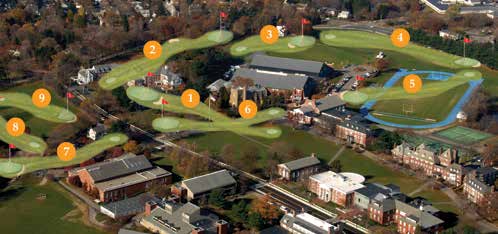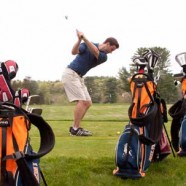
Hole 1
In 1912, Milton Academy decides to establish a golf club. Recognizing this endeavor could create logistical issues, the trustees label it “an experiment.”
“The game of golf is not to be introduced here to compete with the major sports of baseball and football, but to give a comparatively large number of boys and others in the Academy, who cannot participate in these games, an opportunity for some healthful athletic diversion.” — The Milton Orange and Blue, December 1912
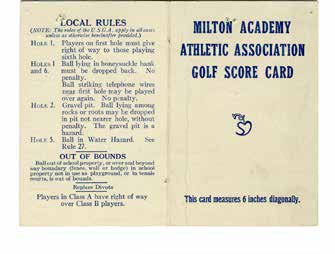 Hole 2
Hole 2
The trustees approve $150 in funds to build the nine-hole golf course on campus. However, there are concerns about the course layout as expressed in this unsigned letter to Headmaster Frank Edwin Lane dated Nov. 29, 1912.
“In hole 2, it is suggested cutting down fifteen trees, which none of the trustees approve of . . . Two of the trustees think this hole would be dangerous when the baseball field is being used . . . I think we all feel that playing on the school side of Centre Street is more or less an experiment and we might want to stop it at a later date . . . The people who will use it most are inexperienced boys who are learning the game and who might be as wild as hawks. I feel sure that if I used the course I would imperil the safety of everybody on the property.”
Hole 3
In May 1913, the club asks the trustees for an additional $137 to cover additional labor expenses and miscellaneous items such as seed and fertilizer. The course is completed and play commences. Over the next few years, numerous “ringer” and “serial” tournaments are played during the fall and spring seasons, culminating with a Graduates’ Cup Tournament held on Graduates Day and open to both students and alumni.
Hole 4
The golf club’s existence is short-lived and comes to an end after the spring 1917 season. When the United States officially entered World War I, the School looked for ways to contribute to the war effort and decided to grow crops on the open land.
“In order that the School may do its share of farming, the golf course has been encroached upon for the use of the five acres that lie across the street from the school house. The students divided into squads of twenty . . . are planting and caring for 3 ½ acres of potatoes and 1 ½ of beans. During the summer, the land will be tended by certain members of the school who live in this vicinity.” — The Milton Orange and Blue, May 1917
After World War I, the Academy’s enrollment doubled in size; Apthorp Chapel and Ware Hall were built; and the School focused on the expansion of the campus.
Hole 5
At some point in the 1970s, golf is resurrected as a club team, playing at the Milton Hoosic Club in Canton, Massachusetts, which is still the home course of the Mustangs. According to Ben Procter ’77, the league was loosely organized and for one match the team “joined forces” with Noble and Greenough in 1977 to play a visiting team from England and were roundly “crushed.”
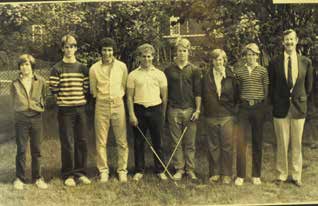 Hole 6
Hole 6
In the 1980s, golf becomes a varsity sport. The first official golf team photo (right) is from 1982.
Hole 7
In 1990, the Joseph Procter Award is established as an annual award for the golf team’s most valuable player. Mr. Procter ’32 was born and grew up in Milton. During his youth, he played an eight handicap until stricken by polio as a freshman at Harvard. Though his right arm was 90 percent paralyzed, Mr. Procter never gave up the game of golf and maintained a handicap in the midteens for most of his adult life. Mr. Procter loved all aspects of the game, especially the camaraderie. In 2011, the award went to freshman Sam Procter ’14, Mr. Procter’s grandson. Ben Procter ’77 was asked to present the award to his son at the M Club dinner.
“That was so special for me, and my father would have been thrilled. The inscription on the plaque speaks to what the award represents: handling yourself correctly on the course, and the importance of sportsmanship.”
Hole 8
In the late ’90s, the team officially becomes coed. Although male players outnumber female players, Milton has a history of powerhouse female players coming out of the program, even before it was coed. Amy Gibbons ’77 played the number-one spot on the club team and won the Women’s Golf Association of Massachusetts Mowatt Trophy in 1975 and 1977. She became a successful Division 1 golf player at Duke University.
In 2006, Claire Sheldon ’06 completed a stellar six-year golf career at Milton. During her tenure, she played in the number-one spot her Class II and Class I years; was the 2005 ISL champion; won the Priscilla Bailey Award; and was 2004 and 2005 Women’s Club Champion at The Country Club in Brookline. She was also a three-time recipient of the Procter Award. Claire is now an assistant golf coach at Harvard University.
“I remember playing in the snow in early April at the President’s Golf Club in Quincy,” says Claire. “It started snowing at the eighth hole, and by the ninth it was snowing really hard. I remember pulling a tee from my pocket, and I couldn’t feel it because my hands were frozen. When I hit the ball on the green, it rolled into a snowball as it made its way to the hole. I remember thinking I will probably never see something like this again.”
Today, Emma Martin ’15 is a rising star. She played the number-three spot her Class II year. She has placed in the top 10 in many national junior golf tournaments, and she came in second for the 2013 Women’s Golf Association of Massachusetts Junior title.
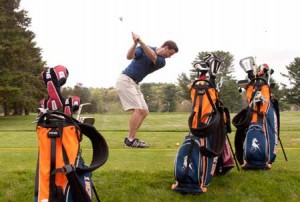 Hole 9
Hole 9
The 2014 season was a success. In a span of six days, Milton’s varsity golf team won eight straight matches without a single defeat. They finished the season in fourth place. Co-captains Sam Procter ’14 and Scott Majkowski ’14 (pictured right) played spots one and two, respectively. Coach Jay Hackett said, “We were lucky to have strong, competitive players in the first four positions; and in the next four positions, we had the ability to play any one of five golfers who are very close in skill. We also have an excellent relationship with and support from the Milton Hoosic Club. We are lucky to have members of this course who really support junior golf.”
Coach Hackett is proud of how the players conduct themselves on the course as they uphold the legacy of the original club, which published a tiny pamphlet in 1917 titled, “What Constitutes a Real Golfer.” The future of the team is promising. With so many interested, young players, there is a possibility of developing a junior varsity team.
— Liz Matson




